Larger Than Everything
By Alison Bennie for Bowdoin MagazineWater.
It covers about 70 percent of the surface of the earth and makes up about the same percentage of the human brain. Its chemical formula is known by almost everyone. It’s the most common substance on our planet and it’s vital for survival.
It’s also a mystery and a beauty and an inspiration. And sometimes the bearer of disease or destruction. It’s powerful, and it has no respect for boundaries. It seeks its own equilibrium. It’s serene and soul-settling one moment and dark and disquieting the next.
It’s also everywhere you look at Bowdoin.
It’s not just Maquoit Bay and Simpson’s Point to the south and the Androscoggin River and Merrymeeting Bay to the north; it’s a destination on an Outing Club paddling or whitewater or camping trip and the field of competition for rowing and sailing and even skiing.
Because it’s all around us in the landscape, we can—because we are human and we are especially good at spotting differences and ignoring things that stay the same—stop noticing it.
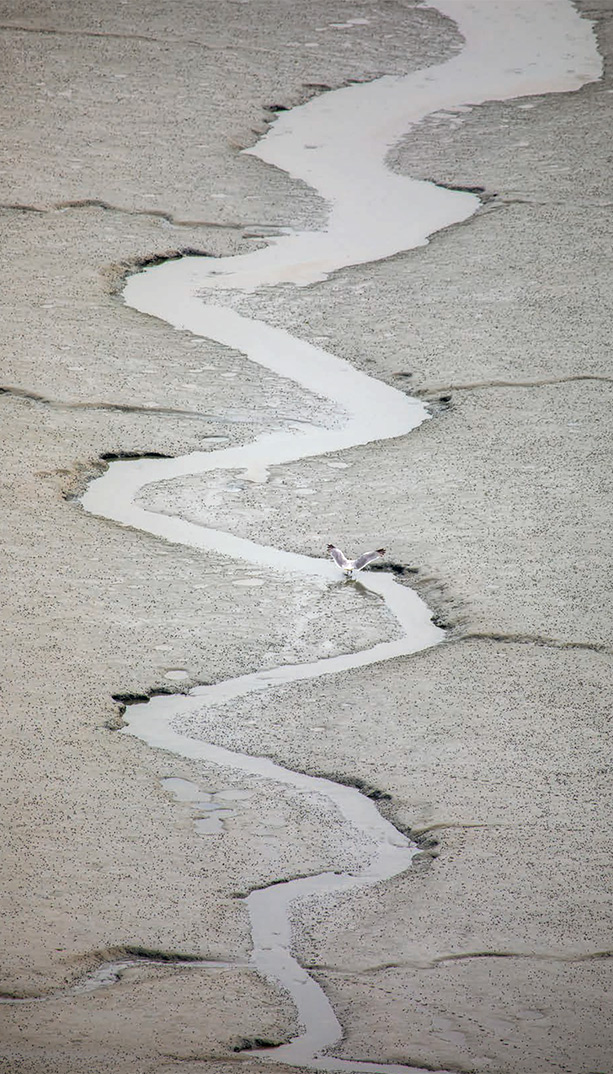
We might especially not notice it in an area where it is actually ubiquitous—the classroom. Marine science and oceanography are the obvious disciplines, of course, and Bowdoin draws many students eager to be on the coast to do that work firsthand with accomplished faculty in the fields of marine and environmental science, biology, oceanography, and geology. But water is also embedded in courses you might not expect: architecture, art, literature, history, education. “As a metaphor, it’s so rich,” says painter and Professor of Art Jim Mullen. “It’s transportation, it’s transformation of space—it has a flexibility and a richness.”
In the course she teaches about the history of western medicine, Assistant Professor of History Meghan Roberts says water is a critical factor in understanding the social and cultural forces that shape health and sickness in the late medieval and early modern period. As one example, she cites physician John Snow’s conviction in the mid-1800s that the cluster of cholera cases around the area of London’s Broad Street water pump indicated that cholera was not, as was thought, caused by “bad airs” or vapors. It was a water-borne disease. And, she says, “Water also comes in implicitly as a way that people are moving around the world. They’re crossing the Atlantic Ocean to the Americas, and that causes a major transmission of disease—European colonialism in general is very much facilitated by ship travel in that period, and colonialism is very significant for spreading disease from place to place.”
Like Roberts, Jill Pearlman, a senior lecturer in environmental studies who specializes in the history of architecture and urbanism, teaches about London and cholera in addition to a host of other ways water is connected to urban development. “In pretty much every class I teach, water comes up,” she says. “Every major city we study, from Paris to Chicago, they are where they are because of water.” She describes teaching about how the Great Stink in London—when the mid-nineteenth-century Thames was so polluted by human and industrial waste that a hot, dry summer created a stench so horrifying that it disrupted parliament and dominated daily life—prompted legislation and, Pearlman says, “completely changed policy and changed the relationship between politicians and people.”
But water is a force not just when it is dangerously unclean. As oceanographer Collin Roesler says, “Water plays a really huge role in the livability of this planet—it is the reason that it is livable. It comes down to the fact that we have ocean, which modulates temperature, and we have water in the atmosphere, which helps trap heat in the greenhouse, in the good sense.”
As one of the first experiences in her Ocean and Climate class, Roesler takes her students down to the Schiller Coastal Studies Center. “Having the ocean right here and having the coastline of Maine be so complex that it provides us with models for all of the ocean and all of the world—I can take them there and I can show them, and they can make measurements and they can figure it out. I want them to get a really intuitive feel for the power of water and how it shapes the world—physically, in terms of climate, and in terms of biology.”
Roesler describes oceanography as a “fresh young field where fresh young eyes and observations that you make as a student can actually contribute to knowledge, even for people like me, who have been at it for thirty years.” She uses that lens to inspire her students to observe, consider why something looks the way it looks, and determine how to use that information to think about how it might look in the future.
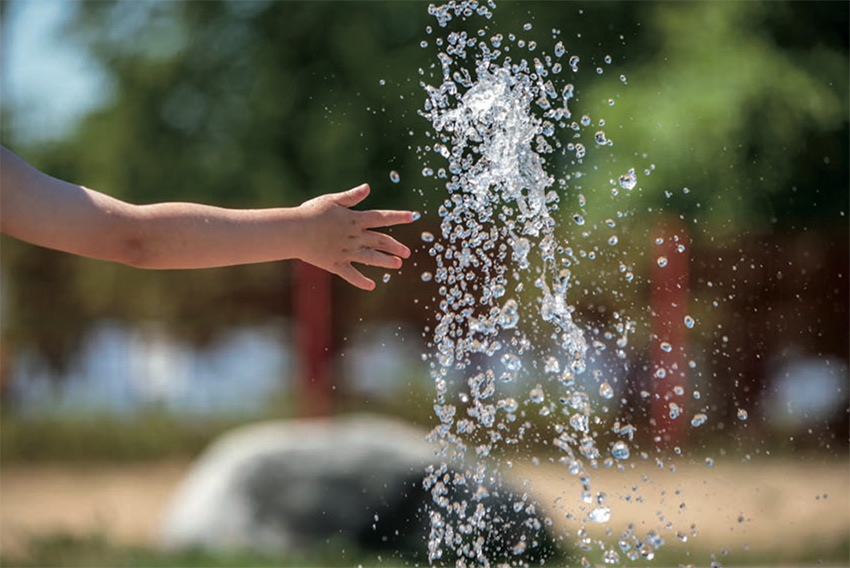
Students in Mullen’s landscape painting class spend the first weeks of the semester outside, learning plein air techniques and, like Roesler’s students, learning to look. “In a digital age, to be asked to slow down and have prolonged attention on something—that generosity of attention reveals things they never thought they would come to understand, or see,” he says. “As simple as that is, it tends to blow them away.”
“When there’s water in a landscape,” he says, “it’s no longer static, because it’s constantly flowing or settling or moving, or in the process of changing, whether it’s a river, the ocean, or even a pond. It’s always doing something.”
English painter David Hockney called painting water “an interesting formal problem ... because it can be anything—it can be any color, it’s movable, it has no set visual description.”
Mullen has firsthand knowledge of the challenges of painting water, which he describes as “one of the toughest things to paint,” but says he is drawn to it again and again regardless. “There’s something about where the land meets the ocean that feels to me like that’s the game—it’s the transition zone from terra firma to mystery and expansiveness. Water just feels like it’s larger than everything, and it ties to everything.”
And water is not just a feature of the landscape—it determines it. As Roesler says, “Water tells us so much about the geologic history. Topography is driven so much by the flow of water and rivers and the retreat of glaciers and the coastline and sea level—all of it. I can’t even look at a landscape without seeing the influence of how water has made it look the way it looks. And the more we look, and the smaller the spatial scale, and the smaller the timescale, the more processes we see. And the challenge for oceanographers is to go from that scale to a global ocean changing over millennia.”
As an educator, she likened that challenge to one that an artist, whether as experienced as Mullen or as new to the task as one of his first-year students, might face. “If you said to someone, you have a minute to paint me an ocean, they’d be like, ‘Okay,’ and they would just cover the surface with blue. And in fact that’s a really great average picture of the ocean. And if you said, ‘I’m giving you an hour,’ then you might find some variation in color, maybe some wave surfaces. But if you gave someone different tools and a very long time, you’d get every facet of the surface with a different reflection of the sky and land around it, and it’s not blue anymore. That’s what I try to do with science—give them the broad brush and then give them the details. Maybe you can’t paint the entire ocean in high detail, but you can paint a little part of it that way.”
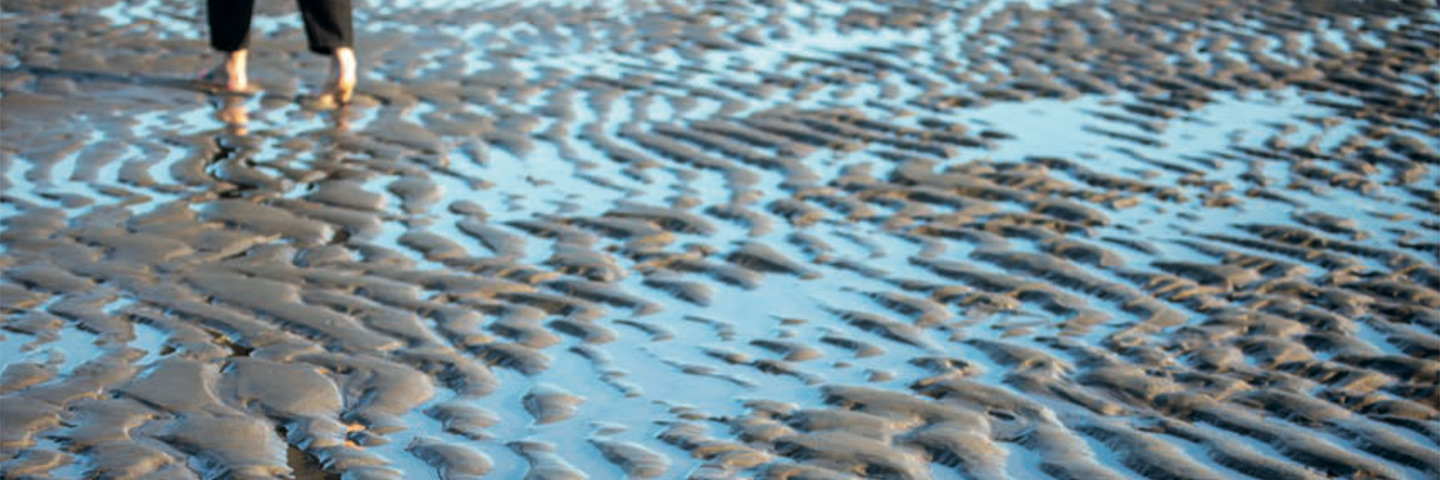
Focusing on an inch-by-inch frame can allow artists to paint a more detailed portrait, scientists to better understand an entire ecosystem, and even writers to best describe a character omnipresent in every story: the place. Associate Professor of English Elizabeth Muther, who is teaching a class on Maine writers and the environment for a course-module in the Bowdoin Marine Science Semester, says, “In Maine, you can’t separate the water from the rugged landscape and its geohistory, its cultural history, its identity.” She describes how she lived and worked in Maine for a number of years before really understanding how central the rivers and lakes are. “I experienced it in going places. I gradually got to understand better the geography, the way the rivers run—I feel that if you understand the water systems in Maine you really understand a lot about this place. The history of what Maine is is so thickly written onto the landscape.”
In addition to teaching Maine writers, Muther asks her students, who take the course while they are in residence at the Schiller Coastal Studies Center, to become Maine writers themselves, developing first a personal narrative piece centered in Maine and then an advocacy essay, in which they locate themselves within an issue like ocean temperature change, research it, and write with a specific audience or publication in mind. “They’re changed by being at Bowdoin,” she says. “They actually are of Maine in some profound way.”
The syllabus for Muther’s class includes works that celebrate Maine and its community, like Sarah Orne Jewett’s The Country of the Pointed Firs, but also complexities like loneliness, loss of water rights, and anti-environmentalism. Not all is safe and beautiful in the Maine environment. Professor of Education Charles Dorn, who is teaching a course this semester about the history of environmental education, says, “We have in our minds this very firmly established link between healthy childhood development and education and access to nature and the natural world.” But in his class he teaches that not only is the assumption unproven in terms of any sort of evidence-driven study, “if you go further back in time historically in the United States, the woods and the wild places were the bad places. That’s where the devil lurked, out in the woods.”
Professor Roberts covers similar ground in her history of medicine course: “In early modern medieval medical theory, the body is seen as kind of porous and very shaped by bad airs, which can spread disease, or people can go to spas and have a water cure. They don’t think of health and the body and the world around it as separate as we do today. The body is influenced and shaped in really dramatic ways by the environment, which is part of what makes the environment so scary.” She shares a specific example studied in class: “When English settlers came to New England, they brought with them sweet little English pigs. But when they set the pigs loose in the woods, pigs have very short generations, and they quickly became wild and their bodies changed very dramatically, which made the English settlers very anxious about what this new environment might do to them.”
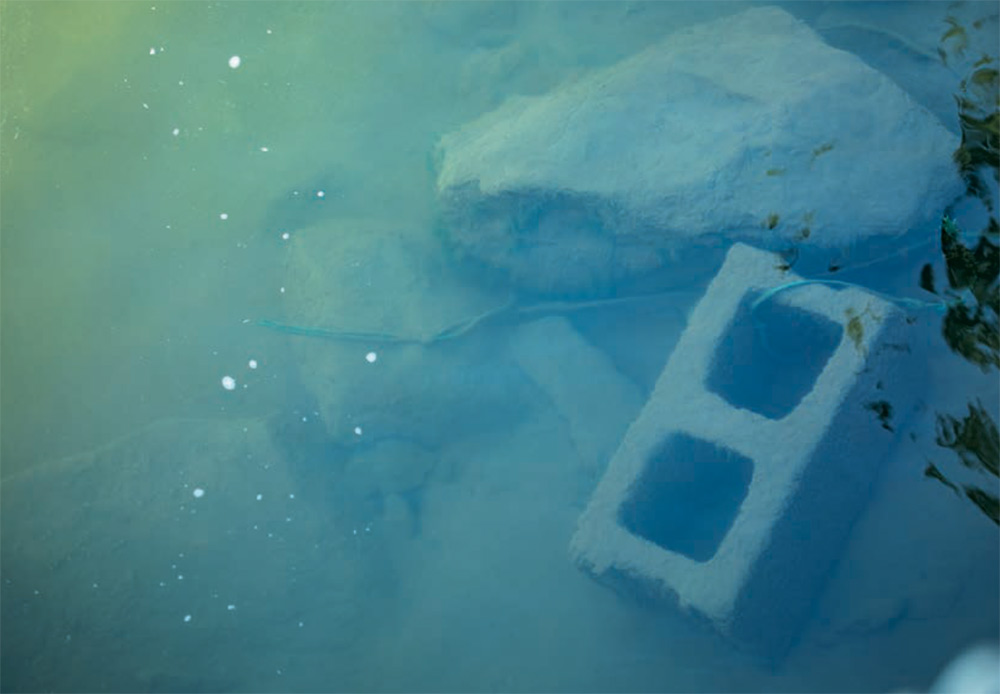
Dorn’s history of environmental education class looks at how such ideas changed and were adapted over time, beginning with a major school reform, especially at the elementary school level, called “nature study.” He says, “We look at zoos, natural history museums, aquariums, and at youth development organizations like Camp Fire Girls, Boy Scouts, 4-H—it’s not a coincidence that most of the Camp Fire Girls and Boy Scout camps are on a pond or a lake; they want kids to be in the water as part of that natural experience.”
The course also examines how popular culture influenced how people saw nature, and he credits much of that early effect to live-action nature documentaries produced by Disney after World War II called True-Life Adventures, which followed animated films like Bambi. “These are the films that established essentially the genre of nature documentary film that has since led to things like Blue Planet, March of the Penguins, any of the films that anthropomorphize animals—you can trace them all back to Disney.”
Other factors influence the role of nature in education. “All of this stuff is heavily influenced by race, class, and gender,” Dorn explains. “These youth development organizations all had the same core principle: if you want to be well educated in whatever particular way, you need to be out in nature. But who has had access to the outdoors, and what form has it taken?”
Roberts says that issues of race, for example, permeate class discussions of medical advancements and how disease was spread around the globe by ships crossing the ocean in the slave trade—not just by transporting people over water from one part of the world to the other but also “because the conditions on the ships were deplorable, very unhealthy and cramped, and surgeons on board used their access to enslaved people to experiment, trying out cures and examining the course of different diseases” as the ships traveled.
In that way, the waterways and the journeys that took place on them allow students to imagine people whose lives and histories we have lost or that were simply never recorded. Muther describes the ways Maine writers they read connect water to history, social development, and power. “I felt as though the writers we were encountering provided an interpretive lens for reading the landscapes of the state,” she says, “even removing the boundaries of this incredible geoculture and allowing us to think more deeply about Indigenous histories and their manifestation in a range of texts.”
Those examples aren’t always taking place in the distant past. Professor Pearlman describes ways water issues intersect with urban development and planning and are also affected by race and class, citing Hurricane Katrina and other recent examples: “Flooding, recovery from flooding, where we build and how we build, how bodies of water can separate communities by social class, how in relation to water social classes are placed in the landscape—it crops up all the time.”
The connections aren’t always focused on lessons we can learn from what water does or brings or even is. Sometimes the connection to water is simply aesthetic or serves as a symbol of what matters to us as people. In her class on Frank Lloyd Wright, a prolific architect most famous for his Guggenheim Museum building and for Fallingwater, a Pennsylvania residence built over a waterfall, Pearlman says water is both a real element and more than that. “He builds in water, but he also uses water as symbols for ritualistic purposes. There’s a temple in Philadelphia with a big water basin in front of it that refers back to the washing of hands before one prays. The sound of water is important to Wright in a number of buildings, the smell of water—he uses it symbolically, ritualistically, and in a sensory way.”
Roesler recognizes that deep sensory connection and wants to empower every Bowdoin student to have it. “One of the things I focus on as an advisor is, let’s make sure everyone can swim.”
She wants to leave them, she says, with a view of the ocean as welcoming. But also to be careful. “The ocean is a friend,” she says, “but the tides are really strong, the currents are really strong, sharks live around here. It’s a friend, but be respectful of the friend, because the friend is really powerful.”
She also acknowledges the reality of climate change and ocean warming. “We do a lot of stuff—pollution in the atmosphere; we dump everything in the ocean; we’ve heated everything up. The ocean has absorbed so much of the heat it has protected us from ourselves on a big, giant, global scale. But there’s a limit to how much more it can do.” She says both her teaching and her students have adapted over time. “Ten years ago we were still in the situation of making sure that everyone understood what was happening,” she says. Now, Roesler explains, “I talk about the Earth as a system with feedback loops. We are going to lose sea ice in the Arctic, and, yes, it’s too bad that this is happening. But for our students there’s tremendous opportunity for thinking about adaptation.”
Mullen says seeing students make connections like these is deeply rewarding. He tells of a conversation with a student in his painting class who had spent the summer doing research at the Retina Institute. A neurobiology major with a deep interest in vision, she was eager to think about seeing in a different way. “They love being around the landscape and with nature. And then we start tying it together with their other classes, and they start having all these points of reference, and they see that it is all interconnected. And that just couldn’t be more exciting.”
Every molecule of water in the world has always been here. The water that bobs Bowdoin sailboats against the dock at Schiller, the spray from the hose that waters the organic garden and all the water we drink, the vastness of Casco Bay and the unfathomable ocean beyond—every drop is billions of years old. Through their ever-shifting existence, they connect everything, offering life, of course, but also lessons, inspiration, and beauty. Because it’s not just the human brain that matches the world in the percentage that is water. It’s also the human heart.
Alison Bennie is the magazine’s executive editor.
Photos by Bob Handelman.
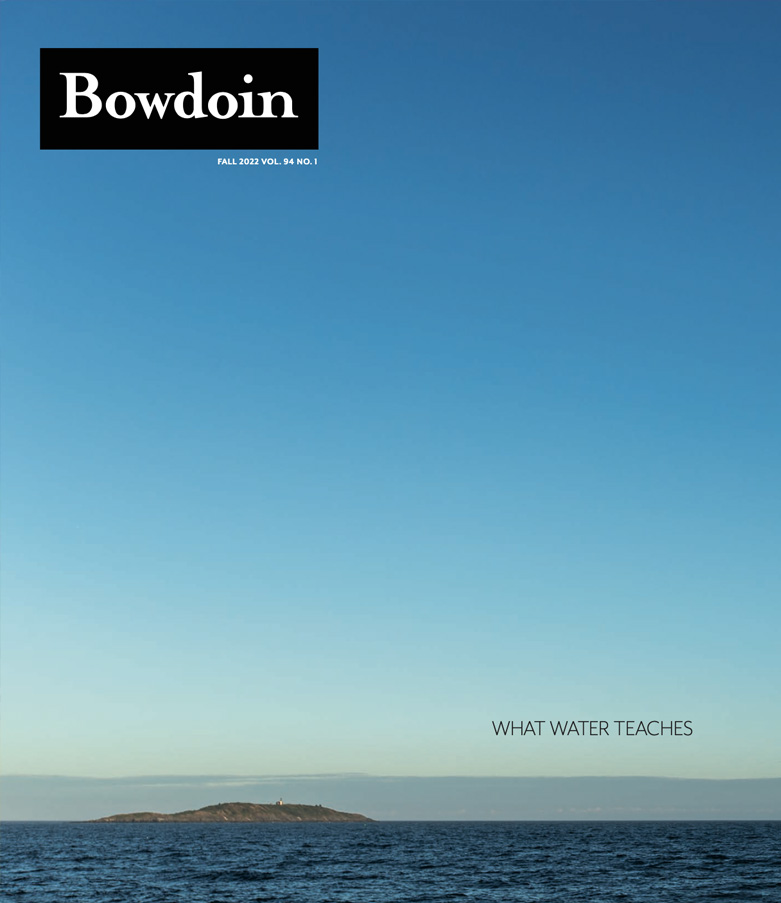
This story first appeared in the Fall 2022 issue of Bowdoin Magazine. Manage your subscription and see other stories from the magazine on the Bowdoin Magazine website.